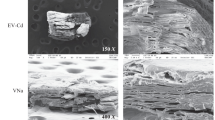Abstract
Vermiculite is a common layered silicate clay mineral which has good adsorption and ion-exchange properties, and which is used to remove pollutants from groundwater. The adsorption by vermiculite from Heibei Province, China, of low-concentration ammonium in water was assessed here to evaluate the effects of adsorption time, particle size, adsorbent dose, pH, and temperature. Using Fourier-transform infrared spectroscopy, the concentration of NH +4 at 1430 cm−1 was evaluated after ammonium was adsorbed by vermiculite. Based on Langmuir-model analysis, the adsorption capacity ofthe Chinese vermiculite (in the particle-size range 0.025–0.075 mm) for ammonium was 18 mg/g after 3 h of equilibration. Optimal adsorption occurred at pH 6–7 and 60°C, which is different from that at high ammonium concentrations. Smaller particle-size fractions showed greater degrees of adsorption. Increase in Mg2+, K+, or Na+ concentrations influenced ammonium adsorption and, therefore, indicated that cation exchange was the mechanism for ammonium uptake from low-concentration solutions.
Similar content being viewed by others
References
Arun, R.G. (1999) Design and construction techniques for permeable reactive barriers. Journal of Hazardous Materials, 68, 41–71.
Boumer, E.J. and Crowe, P.B. (1988) Biological process in drinking water treatment. Journal of the American Water Works Association, 80, 82–93.
David, H.B., Nicholas, A.H., and Richard, A.B. (2000) Performance of air sparging systems: a review of case studies. Journal of Hazardous Materials, 72, 101–119.
Evangelou, V.P. and Lumbanraja, J. (2002) Ammoniumpotassium-calcium exchange on vermiculite and hydroxyaluminum vermiculite. Soil Science Society of America Journal, 66, 445–455.
Famer, V.C. (1974) Infrared Spectra of Minerals. Monograph 4, Mineralogical Society, London, pp. 262–288.
Fetter, C.W. (1993) Contaminant Hydrogeology, Macmillan Publishing Company, New York.
Gilberto, A. and Jorge, C.M. (2003) Influence of pH and ionic strength on removal processes ofa sedimentary humic acid in a suspension of vermiculite. Colloids and Surfaces A: Physicochemical and Engineering Aspects, 226, 25–34.
Gilberto, A. and Jorge, C.M. (2005) Influence of pH, ionic strength and humic acid on adsorption ofCd(II) and Pb(II) onto vermiculite. Colloids and Surfaces A: Physicochemical and Engineering Aspects, 262, 33–39.
Grim, R.E. (1953) Clay Mineralogy. McGraw-Hill Book Co., Inc., New York.
Hu, Y.L., Wu, X.F., and Nie, F.H. (2004) Study ofremov al rate ofammoni um by vermiculite adsorption. Journal of Central South Forestry University, 24, 30–33 (in Chinese).
James, L.C. and Judith, W. (2006) An Apatite II permeable reactive barrier next term to remediate groundwater containing Zn, Pb and Cd. Applied Geochemistry, 21, 2188–2200.
Karadag, D., Koc, Y., Turan, M., and Armagan, B. (2006) Removal ofammoni um ion from aqueous solution using natural Turkish clinoptilolite. Journal of Hazardous Materials, 136, 604–609.
Langwaldt, J.H. and Puhakka, J.A. (2000) On-site biological remediation ofcontaminated groundwater: a review. Environmental Pollution, 107, 187–197.
Lin, L., Chan, G.Y.S., Jiang, B.L., and Lan, C.Y. (2007) Use of ammoniacal nitrogen-tolerant microalgae in landfill leachate treatment. Waste Management, 27, 1376–1382.
Marinos, Y.S. (2007) Removal ofCu(II) in fixed bed and batch reactors using natural zeolite and exfoliated vermiculite as adsorbents. Desalination, 215, 133–142.
Mitsch, W.J. and Cronk, J.K. (1992) Creation and restoration ofwet lands: some design consideration for ecological engineering. Advances in Soil Science, 17, 217–255.
Panuccio, M.R. (2009) Cadmium adsorption on vermiculite, zeolite and pumice: Batch experimental studies. Journal of Environmental Management, 90, 364–374.
Reddy, K.R. and Smith, W.H. (1987) Aquatic Plants for Water Treatment and Resource Recovery. Magnolia Publishing Inc, Orlando, Florida, USA.
Saha, U.K., Taniguchi, S., and Sakurai, K. (2001) K/Ca and NH4/Ca selectivity ofhydroxyalum inum-interlayered vermiculite and montmorillonite: Contribution from regular and frayed edge exchange sites. Soil Science and Plant Nutrition, 47, 455–466.
Schroeder, P.A. and Ingall E.D. (1994) A method for the determination ofnitrogen in clays, with application to the burial diagenesis ofshales. Journal of Sedimentary Research, 64, 694–697.
Scott, A.D., Hanway, J.J., and Edwards, A.P. (1958) Replaceability ofammonium in vermiculite with acid solutions. Soil Science Society of America Journal, 22, 388–392.
Socías-Viciana, M.M., Hermosin, M.C., and Cornejo, J. (1998) Removing prometrone from water by clays and organic clays. Chemosphere, 37, 289–300.
Sawhney, B.L. (1970) Potassium and cesium ion selectivity in relation to clay mineral structure. Clays and Clay Minerals, 18, 47–52.
Vogan, J.L., Focht, R.M., Clark, D.K., and Graham, S.L. (1997) Performance evaluation of a permeable reactive barrier for remediation of dissolved chlorinated solvents in groundwater. Journal of Hazardous Materials, 68, 97–108.
Wu, P.X. (2005) Existing status ofint erlayer water in vermiculite mineral material. Journal of the Ceramic Society, 33, 209–214.
Wu, X.F., Zhao, F., Chen, M.L., Ji, Z.H., and Ma, Q. (2009) A simple way ofcalcu lating the change in the Gibbs’ free energy ofion adsorption reactions. Adsorption Science & Technology, 27, 1–18.
Zheng, H., Han, L.J., and Ma, H.W. (2008) Adsorption characteristics ofammonium ion by zeolite 13X. Journal of Hazardous Materials, 158, 577–584.
Author information
Authors and Affiliations
Corresponding author
Rights and permissions
About this article
Cite this article
Wang, M., Liao, L., Zhang, X. et al. Adsorption of Low-Concentration Ammonium Onto Vermiculite from Hebei Province, China. Clays Clay Miner. 59, 459–465 (2011). https://doi.org/10.1346/CCMN.2011.0590503
Received:
Revised:
Published:
Issue Date:
DOI: https://doi.org/10.1346/CCMN.2011.0590503




